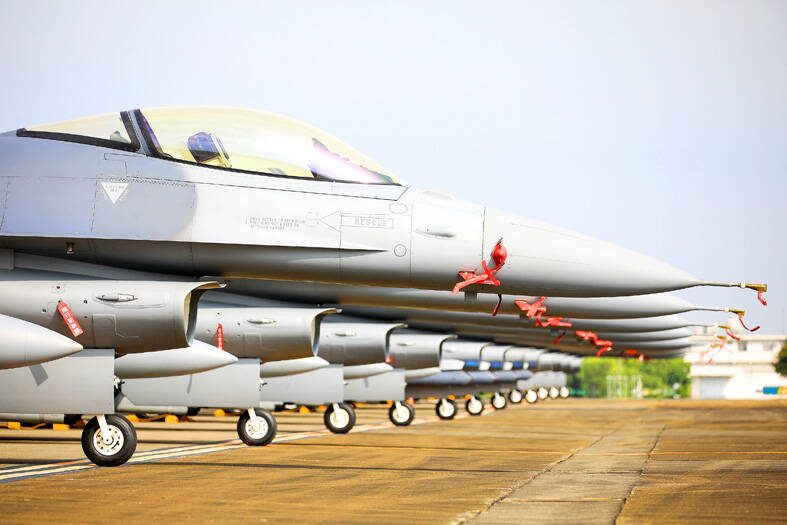The US government on Friday announced arms sales involving spare parts and support for F-16 fighter aircraft and follow-up support for Improved Mobile Subscriber Equipment (IMSE), at a total cost of US$387 million.
It is the 18th arms sale approved by US President Joe Biden’s administration to Taiwan and the sixth since the nation’s presidential and legislative elections on Jan. 13.
The Pentagon’s Defense Security Cooperation Agency (DSCA) said it delivered the required certification notifying the US Congress of the latest arms sale on Friday.

Photo: Cheng I-hwa, Bloomberg
The proposed arms sale is consistent with US law and policy as expressed in Public Law 96-8, the agency added.
The agency in a statement released on Friday said the US Department of State has approved foreign military sales of spare parts and support for F-16 fighter jet and active electronically scanned array radars and related equipment at an estimated cost of US$320 million to Taiwan.
Deliveries are expected to begin next year.
The agency said the proposed sale would improve Taiwan’s ability to meet threats by maintaining the operational readiness of its fleet of F-16 aircraft.
The agency in a separate statement said the US State Department has also approved the sale of follow-up support for IMSE for about US$65 million.
The Taipei Economic and Cultural Representative Office in the US requested the procurement of extended services provided under a previously implemented case, including follow-up support for the IMSE and Experimental Force system.
The proposed sale aims to extend those same services for an additional two years, the agency said.
The two arms sale deals serve “US national, economic and security interests by supporting the recipient’s continuing efforts to modernize its armed forces and to maintain a credible defensive capability,” it said.
The proposed arms sale deals would also “help improve the security of the recipient and assist in maintaining political stability, military balance and economic progress in the region,” it added.
The sale of spare parts and support services for F-16 aircraft would be transferred from US government stock, the agency said.
Implementation of the sale would not require the assignment of any additional US government or contractor representatives to Taiwan, it added.
In terms of the sale of follow-up support for IMSE, the agency said the principal contractor would be General Dynamics Mission Systems, in Fairfax, Virginia.
Implementation of the sale would not require the assignment of US government representatives, but would require three contractor Technical Assistance Representatives being sent to Taiwan to support equipment fielding and training, it added.
In Taipei, the Presidential Office yesterday said the latest arms sale deepened the Taiwan-US security partnership and is an important cornerstone for peace and stability in the Indo-Pacific region.
The Ministry of National Defense expressed gratitude to the US for the latest arms sale, which it said would continue to provide Taiwan with assistance building the nation’s self-defense capabilities and establish a foundation to maintain regional stability.
The sale of spare parts and support for F-16 fighter jets and active electronically scanned array radar logistics is expected to help maintain the combat readiness of the air force’s F-16 fleet and strengthen the country’s air defenses, it said.
The proposed sale of IMSE follow-up support would provide Taiwan with necessary assistance to maintain the effectiveness of its tactical regional communications system, reinforce field information communication capabilities and establish a reliable defense, it added.
The Ministry of Foreign Affairs (MOFA) said it has received a formal notice from the US government for the two proposed arms sale deals, which highlight the efforts of the Biden administration to ensure Taiwan has sufficient self-defense capability to take on threats from China.
MOFA also thanked the US government for approving the two arms sale deals to Taiwan based on the Taiwan Relations Act (TRA) and “six assurances.”
The TRA was enacted in 1979 to maintain commercial, cultural and other unofficial relations between the US and Taiwan after Washington switched diplomatic recognition from Taipei to Beijing. The TRA also requires the US “to provide Taiwan with arms of a defensive character.”
The “six assurances,” which were issued by then-US president Ronald Reagan to Taiwan in 1982, include pledges that the US would not to set a date for ending arms sales to Taiwan and would not hold prior consultations with China on arms sales to Taiwan.

TRAGEDY STRIKES TAIPEI: The suspect died after falling off a building after he threw smoke grenades into Taipei Main Station and went on a killing spree in Zhongshan A 27-year-old suspect allegedly threw smoke grenades in Taipei Main Station and then proceeded to Zhongshan MRT Station in a random killing spree that resulted in the death of the suspect and two other civilians, and seven injured, including one in critical condition, as of press time last night. The suspect, identified as a man surnamed Chang Wen (張文), allegedly began the attack at Taipei Main Station, the Taipei Fire Department said, adding that it received a report at 5:24pm that smoke grenades had been thrown in the station. One man in his 50s was rushed to hospital after a cardiac arrest

A car bomb killed a senior Russian general in southern Moscow yesterday morning, the latest high-profile army figure to be blown up in a blast that came just hours after Russian and Ukrainian delegates held separate talks in Miami on a plan to end the war. Kyiv has not commented on the incident, but Russian investigators said they were probing whether the blast was “linked” to “Ukrainian special forces.” The attack was similar to other assassinations of generals and pro-war figures that have either been claimed, or are widely believed to have been orchestrated, by Ukraine. Russian Lieutenant General Fanil Sarvarov, 56, head

SAFETY FIRST: Double the number of police were deployed at the Taipei Marathon, while other cities released plans to bolster public event safety Authorities across Taiwan have stepped up security measures ahead of Christmas and New Year events, following a knife and smoke bomb attack in Taipei on Friday that left four people dead and 11 injured. In a bid to prevent potential copycat incidents, police deployments have been expanded for large gatherings, transport hubs, and other crowded public spaces, according to official statements from police and city authorities. Taipei Mayor Chiang Wan-an (蔣萬安) said the city has “comprehensively raised security readiness” in crowded areas, increased police deployments with armed officers, and intensified patrols during weekends and nighttime hours. For large-scale events, security checkpoints and explosives

PUBLIC SAFETY: The premier said that security would be tightened in transport hubs, while President Lai commended the public for their bravery The government is to deploy more police, including rapid response units, in crowded public areas to ensure a swift response to any threats, President William Lai (賴清德) said yesterday after a knife attack killed three people and injured 11 in Taipei the previous day. Lai made the remarks following a briefing by the National Police Agency on the progress of the investigation, saying that the attack underscored the importance of cooperation in public security between the central and local governments. The attack unfolded in the early evening on Friday around Taipei Main Station’s M7 exit and later near the Taipei MRT’s Zhongshan